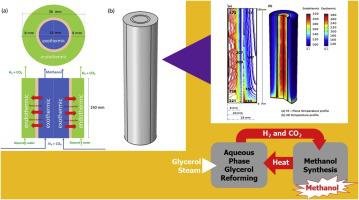Catalysis Today ( IF 5.3 ) Pub Date : 2020-03-23 , DOI: 10.1016/j.cattod.2020.03.043 Sasinun Thirabunjongcharoen , Palang Bumroongsakulsawat , Piyasan Praserthdam , Sumittra Charojrochkul , Suttichai Assabumrungrat , Pattaraporn Kim-Lohsoontorn

|
This study proposes a novel thermally double coupled reactor (TDCR) coupling endothermic aqueous phase glycerol reforming (APGR) with exothermic methanol synthesis (MS), utilizing heat transfer between both channels. Hydrogen (H2) source and availability are known as barriers to carbon dioxide conversion to methanol via MS reaction. Waste glycerol could be a source of H2 through APGR reaction. The steady state TDCR model consists of two concentric channels: 1) an inner tube to which CO₂ and H₂ are fed as reactants for exothermic MS and 2) an outer annulus channel through which glycerol and steam are supplied for endothermic APGR. The TDCR could operate without external heat supply when two reactions were coupled. A computational fluid dynamic (CFD) model was established to study this TDCR. APGR was assumed to be catalyzed by Pt/Al₂O₃ at 200−250 °C and 20−25 bar. MS was modeled with a Cu/ZnO/Al2O3 catalyst at 200−250 °C and 50−80 bar. Heat transfer from the exothermic channel to the endothermic channel helped increase glycerol conversion while methanol productivity is the same as conventional reactor. Cocurrent and countercurrent feed configurations were compared and it was found that the cocurrent configuration offered more uniform temperature distribution in the channel with a larger temperature difference between the two channels. On the other hand, hot spots and cold spots were observed in the countercurrent configuration. Effects of operating conditions of both channels: H2:CO2 and glycerol:steam ratios, inlet temperature, pressure, and total feed flow rate on reactor performance significantly affected the performance of TDCR.
中文翻译:

热双偶合反应器耦合水相甘油重整和甲醇合成
这项研究提出了一种新颖的热双偶合反应器(TDCR),利用吸热水相甘油重整(APGR)与放热的甲醇合成(MS),利用两个通道之间的热传递。氢(H 2)的来源和可利用性是阻碍通过MS反应将二氧化碳转化为甲醇的障碍。废甘油可能是H 2的来源通过APGR反应。稳态TDCR模型由两个同心通道组成:1)内管,向其中通入CO 2和H 2作为放热MS的反应物,2)外环行通道,通过甘油和蒸汽供应吸热的APGR。当两个反应耦合时,TDCR可以在没有外部供热的情况下运行。建立了计算流体动力学(CFD)模型来研究此TDCR。假定APGR在200-250°C和20-25 bar下由Pt / Al 2 O 3催化。MS用Cu / ZnO / Al 2 O 3建模催化剂在200-250°C和50-80 bar下进行。从放热通道到吸热通道的热传递有助于增加甘油的转化率,而甲醇的生产率与常规反应器相同。比较了并流和逆流进料构型,发现并流构型在通道中提供了更均匀的温度分布,并且两个通道之间的温差更大。另一方面,在逆流构造中观察到热点和冷点。两个通道的运行条件的影响:H 2:CO 2和甘油:蒸汽的比率,入口温度,压力和总进料流速对反应器性能的影响显着影响TDCR的性能。


























 京公网安备 11010802027423号
京公网安备 11010802027423号